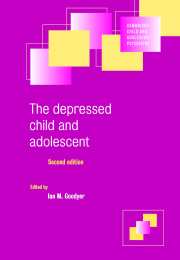Book contents
- Frontmatter
- Contents
- List of contributors
- Preface
- 1 Historical aspects of mood and its disorders in young people
- 2 The development of emotional intelligence
- 3 Developmental precursors of depression: the child and the social environment
- 4 Physiological processes and the development of childhood and adolescent depression
- 5 Childhood depression: clinical phenomenology and classification
- 6 The epidemiology of depression in children and adolescents
- 7 Family–genetic aspects of juvenile affective disorders
- 8 Life events: their nature and effects
- 9 Adolescent depression: neuroendocrine aspects
- 10 Suicidal behaviour in adolescents
- 11 Psychopharmacology of depressive states in childhood and adolescence
- 12 The psychotherapeutic management of major depressive and dysthymic disorders in childhood and adolescence: issues and prospects
- 13 Natural history of mood disorders in children and adolescents
- Index
8 - Life events: their nature and effects
Published online by Cambridge University Press: 18 December 2009
- Frontmatter
- Contents
- List of contributors
- Preface
- 1 Historical aspects of mood and its disorders in young people
- 2 The development of emotional intelligence
- 3 Developmental precursors of depression: the child and the social environment
- 4 Physiological processes and the development of childhood and adolescent depression
- 5 Childhood depression: clinical phenomenology and classification
- 6 The epidemiology of depression in children and adolescents
- 7 Family–genetic aspects of juvenile affective disorders
- 8 Life events: their nature and effects
- 9 Adolescent depression: neuroendocrine aspects
- 10 Suicidal behaviour in adolescents
- 11 Psychopharmacology of depressive states in childhood and adolescence
- 12 The psychotherapeutic management of major depressive and dysthymic disorders in childhood and adolescence: issues and prospects
- 13 Natural history of mood disorders in children and adolescents
- Index
Summary
Introduction
A life event is an environmental circumstance that has an identifiable onset and ending and may carry the potential for altering an individual's present state of mental or physical well-being. Such circumscribed happenings should be discriminated from other forms of longer-term ongoing experiences which may carry the same or similar effects but do not have readily identifiable onsets and endings. When either of these two forms of environmental experience are considered undesirable and exert a negative impact in the days and weeks after exposure they carry the potential for increasing the liability for mental and behavioural symptoms and syndromes and psychosocial impairment. Twentieth-century psychosocial theories of depression were founded on the assumptions that undesirable social experiences, such as loss of a loved one, result in enduring psychological change for some individuals that give rise to the negative cognitions and related signs and symptoms that characterize depressive disorders. Whilst there is now considerable evidence that undesirable life events do precede and increase the risk for depression in adolescents and adults, how they exert their effects remains unclear.
Evaluating events and difficulties
It is now widely accepted that event evaluation should include a description of the nature and characteristics of the circumstance to include qualitative differences in the content of life experiences between persons (Brown & Harris, 1978; Paykel, 1978). Brown & Harris (1978) demonstrated that, by doing this, the latent psychological effects of socially differing events between individuals can be reliably and validly compared.
Keywords
- Type
- Chapter
- Information
- The Depressed Child and Adolescent , pp. 204 - 232Publisher: Cambridge University PressPrint publication year: 2001
- 20
- Cited by



